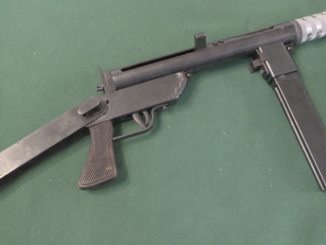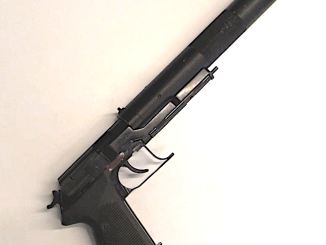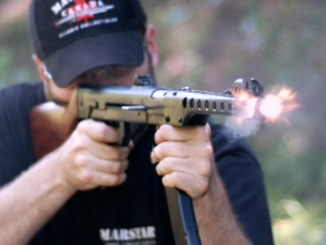With Poland’s entry into NATO in the 1990s, a new service rifles was needed, chambered for the 5.56mm NATO cartridge. Initial development work had been done in 1990/91 to adapt the wz.88 Tantal to 5.56mm, and this project was dusted off in 1995 to create the Beryl. Essentially a Tantal in 5.56mm, the Beryl includes an improved folding stock, a shorter muzzle device (and correspondingly longer rifled barrel) and a new handguard design.
Initially adopted in 1996 as the wz.96, the Beryl has undergone several mid-life improvements. These include the addition of a Picatinny optics rail, collapsing stock, and improved safety and magazine release. The basic mechanics, however, remain the same as the Tantal, with a left-side selector switch allowing semiauto, full auto, and 3-round-burst firing options.




Now, this looks like a decent rifle to me, with FNC inspired buttstock. A lot better in every way that the previous model. Thru similar “tantalizing” process went Czechs, having prepared 5.45mm Lada into production in early 1990s, later changing it into 5.56mm reconfigured CZ2000 and eventually ending up with what they call Bren A. Even that was not the last step, as similar development in Poland shows.
It could be subject of speculation what would have happened if they were not integrated into NATO. Would they keep the original caliber or developed jointly something new? After all we are heading now into a brand new caliber in 6.8mm.
I think that without NATO integration they would have kept 7.62×39. Most armies that did not use 5.56 kept it – it does the job, it has more options available (including Chinese developments) and it changing the service round costs quite a lot of money.
Many people (including the author of the blog) strongly doubt that 6.8 will replace 5.56. Specialty weapons for special forces – of course; switching all SAW to it – possible (many nations quite happily use PKM and its derivatives side-by-side with rifles in 7.62×30/5.45/5.56, so using the different type of ammo in the SAW is not an insane proposition); using it as the only infantry rifle round – unlikely.
“(…)7.62×30(…)”
What is that?
“(…)they would have kept 7.62×39(…)”
wz. 96 did spawned 7,62×39 although it was made for export – namely M762
https://modernfirearms.net/en/assault-rifles/poland-assault-rifles/wz-96-beryl-eng/
“(…)7.62×30(…)”
What is that?
7.62×39, obviously. I was not talking about some super-obscure round (writing just 7.62 would be not really clear because I was just talking about using full-sized rifle 7.62 ammo in a SAW).
Modern body armour has improved considerably over the last decades, and the slow 7.62×39 must be considered obsolete against enemies who have access to armour.
Stopping 7.62×39mm still requires hard plates, which means that in practice the same armor will usually protect also against 5.56/5.45mm. For practical purposes 7.62×39mm is therefore still as good as the more modern small caliber intermediate cartridges.
That must be definitely so, otherwise Pakistan and India would not buy new rifles in that (7.62×39) caliber.
“For practical purposes 7.62×39mm is therefore still as good as the more modern small caliber intermediate cartridges.”
Classes as laid by ГОСТ Р 50744-95 (does reign since 2014 year)
https://ru.wikipedia.org/wiki/%D0%91%D1%80%D0%BE%D0%BD%D0%B5%D0%B6%D0%B8%D0%BB%D0%B5%D1%82#%D0%9A%D0%BB%D0%B0%D1%81%D1%81%D1%8B_%D0%B7%D0%B0%D1%89%D0%B8%D1%82%D1%8B
does agree with that. According to it class 4 does provide protection against
5,45 mm cartridge 7Н10 with ПП bullet fired from AK-74
and
7,62 mm cartridge 57-Н-231 with ПС bullet fired from AKM
The US Army is planning to buy only 125,000 of the 6.8mm rifles. Just enough to equip the infantry and similar units. Everyone else keeps their M4 or M16. I’m not sure what the Marine Corps plans to do, although they are involved in the project. The Air Force declined to participate, opting to search for a better optic for their existing assortment of AR-15s, M16s, M4s, and GUU-5s.
Once this (6.8×51) gets fielded, the rest will soon follow. The 5.56 is known for its deficiencies, although nearly impossible efforts were made to keep it alive. In addition, there will be no need for the venerable 7.62×51; result will be streamlined logistics. It is also likely that the .338 will replace .50BMG. It seem to make sense, after all those years of haggling.
If the 6.8mm gets fielded by US military, it will take a long time before anybody else in the NATO will follow, if ever. Most, if not all of the NATO countries seem to be happy with 5.56mm and many have either fairly recently transitioned from 7.62mm or fielded new weapons in 5.56mm. They see 6.8mm as a fairly pointless “optimization” project, which let’s face it, it largely is, rather than a necessity addressing any significant real life shortcoming. At least if you don’t plan on fighting the Taleban in Afghanistan for another 20 years…
I also don’t see how .338 could replace .50 BMG in all applications. The former simply does not have the penetration, even if it does have the range.
I doubt that the 6.8mm will happen. I further doubt that Milley is going to survive the next few years, professionally, and that any of his pet projects are going to ever come to fruition.
The entire concept is predicated on false premises. You would have to be nuts to think that a.) you are ever going to have a “combat troops only” caliber, or that b.) you’re going to see situations going forward where you can afford to draw such a fine line between “combat” and “everyone else”.
My guess is that if the delusionals force this through, it’s going to work out very, very badly for any and all concerned. Which, considering the increasingly “woke” nature of our military, may not be a bad thing for the citizenry.
“they were not integrated into NATO.(…)Would they keep the original caliber or developed jointly something new?”
I bet first is more probable. With end of Cold War funding for military development dwindled. Also keep in mind that 5,45 mm is dubbed wzór 88 for 1988 year of adoption. Do you think decision makers would be happy to submit “yay we need totally new weapon and totally new cartridge as our current is less than 10 year old” (Poland become NATO member at 1999)
Lada always reminds me of a car, thus its not a good gun nams…
If this name is disturbing for you, you might use another one: CZ-2000
https://modernfirearms.net/en/assault-rifles/cz-2000-lada-2/
Also this is not first case of such name sharing, for example in dawn of 20th century BAYARD was used for automatic pistol (Pieper Bayard), adverts for automobiles made by manufacturer Clément-Bayard
https://en.wikipedia.org/wiki/File:Cl%C3%A9ment-Bayard_advertising_poster,_circa_1905.jpg
and even lighter-than-air vehicles like https://www.thisdayinaviation.com/tag/clement-bayard-no-2/
I’m sure there was a Bullpup mock up aswell.
If you mean JANTAR it was not just “mock up” but fully functional prototype
see 1st photo from top https://pl.wikipedia.org/wiki/Karabinek_wz._2005_Jantar
“The only 5.56 AK specifically adapted for military applications… Galil?
Galil is not an AK variant, although based on AK
The DDR East German Wieger Stg. was designed for export sales to Peru and India. The wall came down, the most rapid reunification plan was set in motion, and the CDU government “vertically filed” the whole thing, and even paid fines for breach of contract. The factory at Wiesa that had produced Kalashnikows und so weiter for the old Marxist-Leninist regime’s NVA, VoPo, Luftsreitskraefte, etc. etc. and also mischief makers. Workers unemployed, hit the bricks alongside so many other now redundant workers in the “new Laender.”
I’d think the contract might have gone through, solved India’s apparently unsolvable problems with a service rifle, gotten some dosh from Peru, given some people a transition to another factory job or some other kind of retraining, and, hey? Why not! Be on hand for the G-36/H u. K fiasco… Although I don’t see France, say, buying the Wiesa to replace the FAMAS like they did with the Oberndorf produkt. …
Yugoslavia officially adopted 5.56mm M85 in 1987.
A quick note that the dimensions for the muzzle device probably conform to the defacto standard within NATO
“The first rifles to utilize the 22mm grenade were the American M1903 Springfield, M1 Garand and M1 Carbine, all of which required an adapter (the M1, M7, and M8 grenade launchers, respectively). After the formation of NATO, the 22mm grenade was adopted as its standard rifle grenade. The French have been producing 22mm grenades fired with 7.62×51mm NATO rounds since 1956. Many NATO small arms, such as the West German Heckler & Koch G3, French MAS-36/51, MAS-49/56 and FAMAS, British SA80, and American M16/M4 are equipped to launch 22mm grenades without an adapter. The same 22 mm thread diameter for these rifles has also been referred to as a “STANAG muzzle device” size for flash hiders and other attachments by civilian firearm traders.”
https://en.wikipedia.org/wiki/22_mm_grenade
Men equipped with these rifles won the largest battle the Polish Army fought since the WW2 (if we mercifully forget some engagements of Ludowe Wojsko Polskie against the Polish anti-communist resistance in late 1940′ and a few skirmishes against the UPA, occasionally reaching battalion-size, though perhaps not the firepower):
https://pl.wikipedia.org/wiki/Obrona_ratusza_w_Karbali